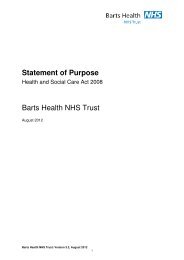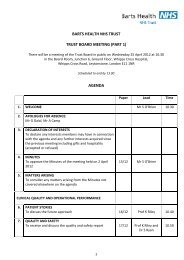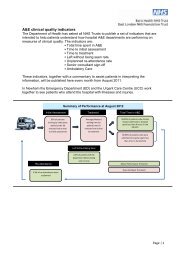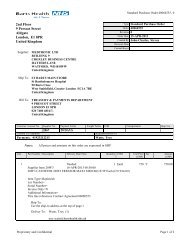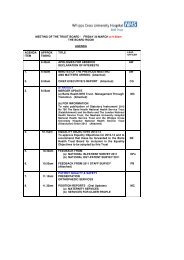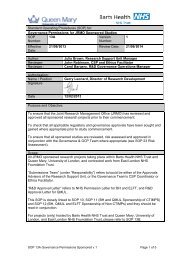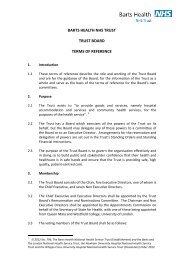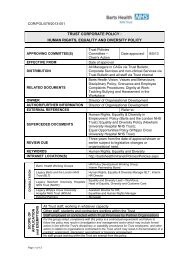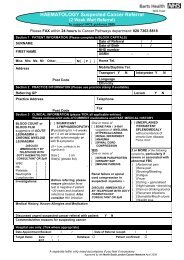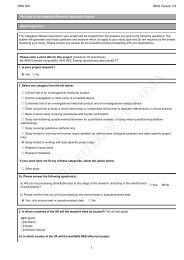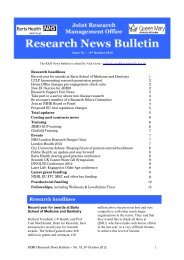Barts Health Equality and Human Rights Impact Assessment Report
Barts Health Equality and Human Rights Impact Assessment Report
Barts Health Equality and Human Rights Impact Assessment Report
- No tags were found...
You also want an ePaper? Increase the reach of your titles
YUMPU automatically turns print PDFs into web optimized ePapers that Google loves.
<strong>Barts</strong> <strong>Health</strong> <strong>Equality</strong> <strong>and</strong> <strong>Human</strong> <strong>Rights</strong> <strong>Impact</strong> <strong>Assessment</strong> <strong>Report</strong>4.2 Improving patient experience <strong>and</strong> human rights protectionAll three Trusts have acknowledged they face challenges in improving patient experience.This project has identified a number of challenges for the new organisation in relation toequality <strong>and</strong> human rights. Particular groups of people (younger people, ethnic minorities,<strong>and</strong> women) are more likely to say they are not treated with dignity <strong>and</strong> respect. Thebaseline review recounts stories from a minority of people who feel they had their humanrights infringed <strong>and</strong> people who were genuinely fearful of returning to receive care due topoor experiences <strong>and</strong> significant threats to their health <strong>and</strong> safety.It would be tempting to follow this up by consulting specifically with people only from each ofthese protected characteristics to underst<strong>and</strong> why they feel they are not being treated withdignity <strong>and</strong> respect. There are significant benefits to doing this. Yet the rapid baseline reviewin this report has shown how there can be a number of common themes that, if addressedacross all frontline staff behaviour, would have an impact on patient experience <strong>and</strong>protection of human rights for a wide range of traditionally excluded groups. For example, acommon theme that came out across a broad range of (specifically ethnic group)consultation sessions on End of Life Care conducted by Newham LINkS was the need for‘patient choice’ <strong>and</strong> autonomy. Patients felt that they did not always have a say in theirtreatment <strong>and</strong> that services could be improved by making choices explicit to people.As care pathways are further developed, there will be opportunities for CAGs to work withlocal people to identify relevant aspects of staff behaviour that could be improved in order todeliver more compassionate <strong>and</strong> responsive care. We would encourage CAGs to thinkcarefully about how ‘difference’ <strong>and</strong> ‘diversity’ is responded to. Whilst specific communitygroups may have specific requests, it will be important for CAGs to make proportionate <strong>and</strong>reasonable decisions about how the majority of people’s rights are protected across the carepathway. It may be proportionate to respond to particular inequalities in a targeted way (forexample, the provision of specific language support or adjustments for disabilities), butsometimes mainstream change across the whole system will be a more effective <strong>and</strong>proportionate use of resource, <strong>and</strong> will benefit a wider range of people.One way to approach this would be to trial a similar approach to the one taken by MacmillanCancer Support in their <strong>Human</strong> <strong>Rights</strong> St<strong>and</strong>ard for Cancer Care. The st<strong>and</strong>ard wasdeveloped by brap following consultation with over 400 patients, carers, <strong>and</strong> staff to identifythe eight key ‘moments that matter’ in a particular care pathway. Staff behaviours wereidentified that, if followed, would help to ensure patient rights are protected in thosemoments that matter (examples include: making sure that important conversations are heldin a private space; ensuring food is not out of patients’ reach; <strong>and</strong> making sure that patientshave an opportunity to discuss <strong>and</strong> influence their care in a way they underst<strong>and</strong>). Therewas a high degree of convergence <strong>and</strong> agreement around what those ‘moments’ should looklike across people from a range of protected characteristics <strong>and</strong> across professionals. Byensuring staff are equipped to deliver against a st<strong>and</strong>ard that responds to issues like this,211



